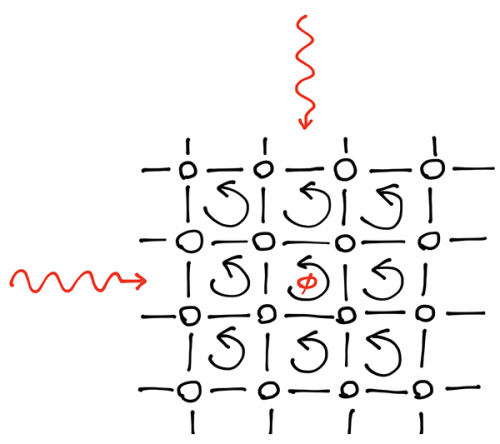October 30, 2013 weblog
Two teams use cold atoms and lasers to create a system that should exhibit Hofstadter's butterfly

(Phys.org) —Two teams working independently of each other have created systems that are expected to exhibit Hofstadter excitations (a butterfly). One team was run by lead researchers at the University of Munich and the Max Planck Institute in Germany, the other by a team at MIT. Both have published papers in the journal Physical Review Letters, detailing their nearly identical systems and results.
Hofstadter's butterfly is a theoretical fractal pattern first suggested by physicist Douglas Hofstadter back in the late 1970s. He believed that a fractal pattern resembling a butterfly should come about in the energy spectrum of electrons as they exist in crystalline solids—if they are exposed to an extremely strong magnetic field. Because the means for creating such a magnetic field is unfeasible, no one has ever been able to test the theory by creating an actual system to see if the butterfly would appear, though several have built systems that mimic the theory using other materials. In this latest effort both teams are doing just that, setting up systems that mimic the system described by Hofstadter, in order to give credence to the theory. Both teams report that they have set up their individual systems in a way that they believe will cause the creation of the butterfly to appear, though neither has taken the system to the point thus far where it has actually appeared, however.
In Hofstadter's theory, the butterfly should appear in a system where electrons are caused to exist in a lattice of electrons, due to their natural spin, when exposed to a massively strong magnetic field. In this new effort, both teams instead used lasers to cause super-cooled rubidium atoms to line up in an optical lattice, then used other lasers to knock the atoms around and to cause them to spin, simulating the natural motion of electrons in a lattice when exposed to a very strong magnetic field.
If the technique is ultimately successful, the researchers believe it will lead the way to developing new methods of simulating super-strong magnetic fields (because the system is easily adjusted), which could lead to the creation of new models to help solve quantum mechanical problems that exist under such conditions.
More information: Realization of the Hofstadter Hamiltonian with Ultracold Atoms in Optical Lattices, Phys. Rev. Lett. 111, 185301 (2013) DOI: 10.1103/PhysRevLett.111.185301
Realizing the Harper Hamiltonian with Laser-Assisted Tunneling in Optical Lattices, Phys. Rev. Lett. 111, 185302 (2013) DOI: 10.1103/PhysRevLett.111.185302
Journal information: Physical Review Letters
© 2013 Phys.org




















